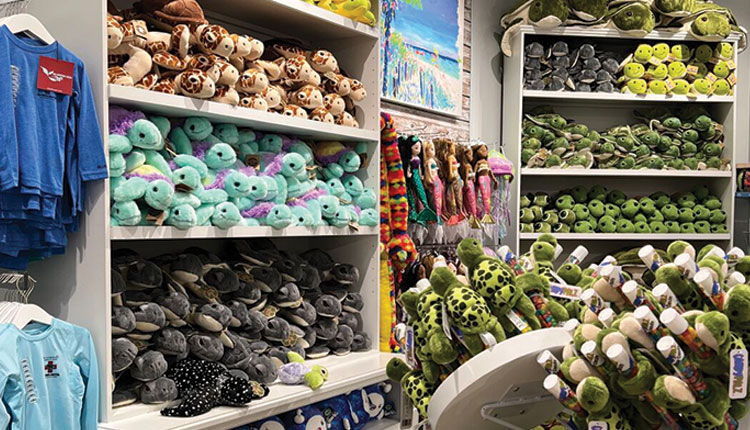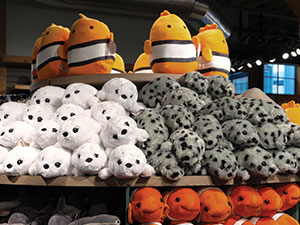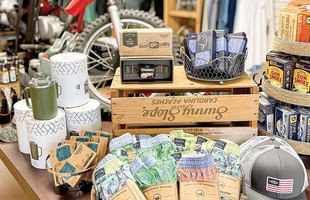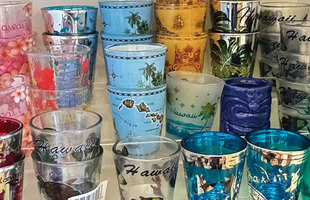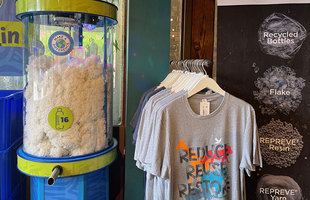People love visiting aquariums and rescue centers to see beloved marine life in action: the sharks, the seals, the sea turtles and multicolored fish from around the globe. There’s something awe-inspiring about taking time to view creatures who dwell in the world’s vast ocean environment.
But these attractions often do more than simply showcase what’s out there to tourists and local marine enthusiasts — conservation and marine rescue efforts are often at the heart of these operations. Ticket and retail sales typically help these organizations to advance these sea-focused causes.
Loggerhead Marinelife Center in Juno Beach, Florida, was established with the mission to promote the conservation of ocean ecosystems with a special focus on threatened and endangered sea turtles. Jessi Louw, senior retail operations manager at Loggerhead, says gift shop sales support 40% of the center’s operational costs.
“It does emphasize how important this department is to the day-to-day operations,” she says.
Bev Singer, merchandiser for the center, explains that the shop carries merchandise that will appeal to any visitor, and plush certainly fits that bill, making up 12% of gift shop sales.
“One would think maybe it’s just little children who want plush, but it’s a lot of adults, too,” she says, adding that the destination retailer sells plush with the whole family in mind.
Countless critter options
With a focus on helping sea turtles, it comes as no surprise that sea turtles are the most popular plush featured at the Loggerhead Marinelife Center gift shop.
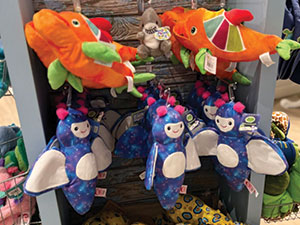
Guests can’t miss the tall shelves full of plush at the Loggerhead Marinelife Center gift shop, which carries a variety of sea life in plush form.
“The majority of our plush is sea turtles, all different species of them,” says Louw.
Even though sea turtles are the attraction’s specialty, the shop carries many other sea creatures in plush form to offer variety.
Singer notes, “Some of our stuffed sea turtles look very realistic. Then other plush are pink, have rainbows, bows or eye lashes. We have every shape, every color, every size. We really do believe we have plush for everyone.”
Jasmine Ramirez, store director at the Seattle Aquarium Gift Shop, takes a similar approach when stocking plush for the aquarium gift shop. Sea otters are fan favorites at Seattle Aquarium, so the store has plenty of sea otter plush, but Ramirez fills out the category with many other lovable sea creatures, such as harbor seals, octopus, sharks, seahorses and axolotls.
“Axolotl are trendy,” she says. “It’s not a species we have here, but it’s trending big time in the marketplace, so we added axolotl into our plush assortment. Every year, we get a few trending or seasonal things we rotate into our merchandise mix.”
In addition to carrying different species of plush, aquarium and rescue center retailers often have various sizes and price points for these products. Customers also like when retailers carry some eco-friendly options.
Ramirez notes that the shop has been stocking more eco-friendly stuffed animals made of recycled water bottles.
“Our eco-friendly plush are so soft that I can’t believe they’re made from recycled plastic!” she adds. “There are good options out there. As an institution, we’re focused on transitioning to plastic-free options when possible.”
Louw adds that Loggerhead Marinelife Center’s gift shop also has a growing inventory of plush made from recycled material.
“That helps to highlight our commitment to reducing waste and promoting recycling,” she says.
Perfect placement
Plush might be fun for people of all ages, but it generally sells best among kids. For that reason, aquarium and rescue center retailers say they often like to keep most of their plush in their kids’ sections.
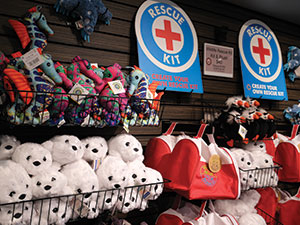
At the Seattle Aquarium Gift Shop, the plush mountain stands out to customers as well as its wall with plush baskets and toy rescue kits.
Even though Singer says most of the plush at the Loggerhead Marinelife Center gift shop is in the back of the store, customers can’t miss it. Three tall bookshelves that stretch all the way to the ceiling are packed with plush. Large sea turtle plush sit on the very top of the shelves, purveying the store. The retailer also has some baskets scattered in the area filled with smaller plush options.
Tucked within the shop’s kids’ section, the Seattle Aquarium gift shop houses most of its plush on a round display Ramirez likes to call “plush island.”
“Core plush pieces go there,” she says. “We also have a small wall with animal rescue kits and smaller plush.”
In Los Angeles, Marine Mammal Care Center renovated its gift shop in January. Gift Shop Manager Kathy Lee notes that the area needed to be opened a bit to feature more displays and educational offerings.
Since the renovations, Lee says the shop has had success stocking its plush in two different areas to make sure customers can’t miss them.
“The store designer set up zones with the plush across an entire section of the wall,” she explains. “We also have some plush placed in other displays to fill out the space.”
Although plush typically sells best around kids’ merchandise, aquarium and rescue center shops occasionally like to sprinkle them around other parts of the stores to help displays and other merchandise pop.
Lee adds that destination retailers also shouldn’t be afraid to move plush around a bit to see where it will sell best. “We do move things around the gift shop area if they aren’t selling as well as we would like.”
Set up for success
Since plush comes in all shapes and sizes (just like animals do), setting up the perfect plush display or section can be tough. Ramirez says it’s important to get creative when organizing plush.
“There is a bit of a science to stocking plush,” she says, explaining that sea otters often look better when she lays them on their backs while she might place a bunch of fish plush in a bucket. “I learned to think of plush like soldiers. Find a way to keep them nice and neat, but also get creative with it.”
Ramirez says keeping her plush section neat can be a daily battle, though. Plush occasionally falls out after a customer pulls some out to feel, or some items are misplaced. She says store associates regularly help to make sure the plush area stays stocked and tidy.
Louw notes that kids often get excited and move toys and plush around. She says the store leans on its sales associates and volunteers to keep its plush area looking top-notch throughout the day.
“We work closely with our volunteers since the center has a big volunteer community, and we do have volunteers in the store who help us keep the store clean,” she says.
Singer adds that the store has a stock associate who comes in each morning to make sure plush is fully restocked. “We get very busy during the day. It’s easier for us to restock in the morning — take a quick look and make sure it’s full,” she says. “We always want the plush area looking full and packed.”
Singer also has a winning technique for making the store’s plush stand out — make sure all the eyes are facing out at the store.
“Part of keeping the store neat includes all eyes looking out,” she says. “It may sound kind of silly, but my thoughts are you’re seeing a thousand plush turtle eyes watching you, saying, ‘Please take me home!’”
